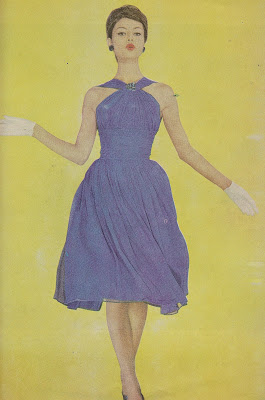Apparently, the woman here is a "fake beatnik in fake fabrics."
Today's translation: A thrifty vegan (wannabe?) hipster. Right?
sounds almost like me!
Paging through a Cosmopolitan Magazine from February 1960 this editorial on thrifty shopping grabbed my attention; "Fakes, Good Taste, No Money." It profiles fashion photographer Erwin Blumenfeld as he assists a young woman shop for an entire outfit for under $20. (with inflation that's over $150! *)
He gives the following tips on scoring the best deals at "basement" shops. Verbatim.
 |
| Cosmopolitan, Feb. 1960 Lyn Tornabene |
|
|
|
|
|
You wouldn't want your mother giving you bum steers, now would you? wink.
Below are some direct excerpts from this editorial.
(Left) $8. Plaid Corduroy suit for "shopping, social work, or getting
the bosses job" is a composite of Blumenfeld's fashion philosophies:
"Underaccessorize rather than overdo matters; one wrong jewel can
destroy all elegance. Don't try to match too much. And wear a hat only
if you want to look like an executive."

(Right) $6 This nylon chiffon is from the "Specials" rack of a chain store. "This is a sensational gown," says Blumenfeld. "It looks like one hundred dollars worth of dress."Jewelry cost $2.50; gloves $4.
Sure is Mr. Blumenfeld.
Isn't this fun? I adore the ironies and similarities of these rules- and even vocabulary- to today.
* I found a really fun website for those who are interested in economics (ha!) No really, to calculate the worth of a dollar in any year compared to what it is today. Go to:
It's incredible to know that is cost just $1,500 to buy a Ford Thunderbird in 1955. Adjusted for inflation that's $12,685.
Can I have a time machine, please?



























